Comprehensive Report on Contract Law Principles and Applications
VerifiedAdded on 2020/01/16
|13
|4931
|129
Report
AI Summary
This report provides a comprehensive overview of contract law, beginning with the essential elements of a valid contract, including offer, acceptance, consideration, and contractual capacity. It explores different types of contracts, such as void, voidable, bilateral, and written contracts, and analyzes various contract terms, including exclusion clauses, breach of contract, and guarantees. The report then examines the elements of a contract in a business context, analyzing the consequences of classified terms like warranties, conditions, and innominate terms. Furthermore, it contrasts liability in tort with contractual liability, focusing on the nature of liability in negligence and how a business can be vicariously liable. The report also discusses the elements of the tort of negligence and defenses, as well as the elements of vicarious liability in a given scenario, offering a complete understanding of contract law principles and their practical applications.
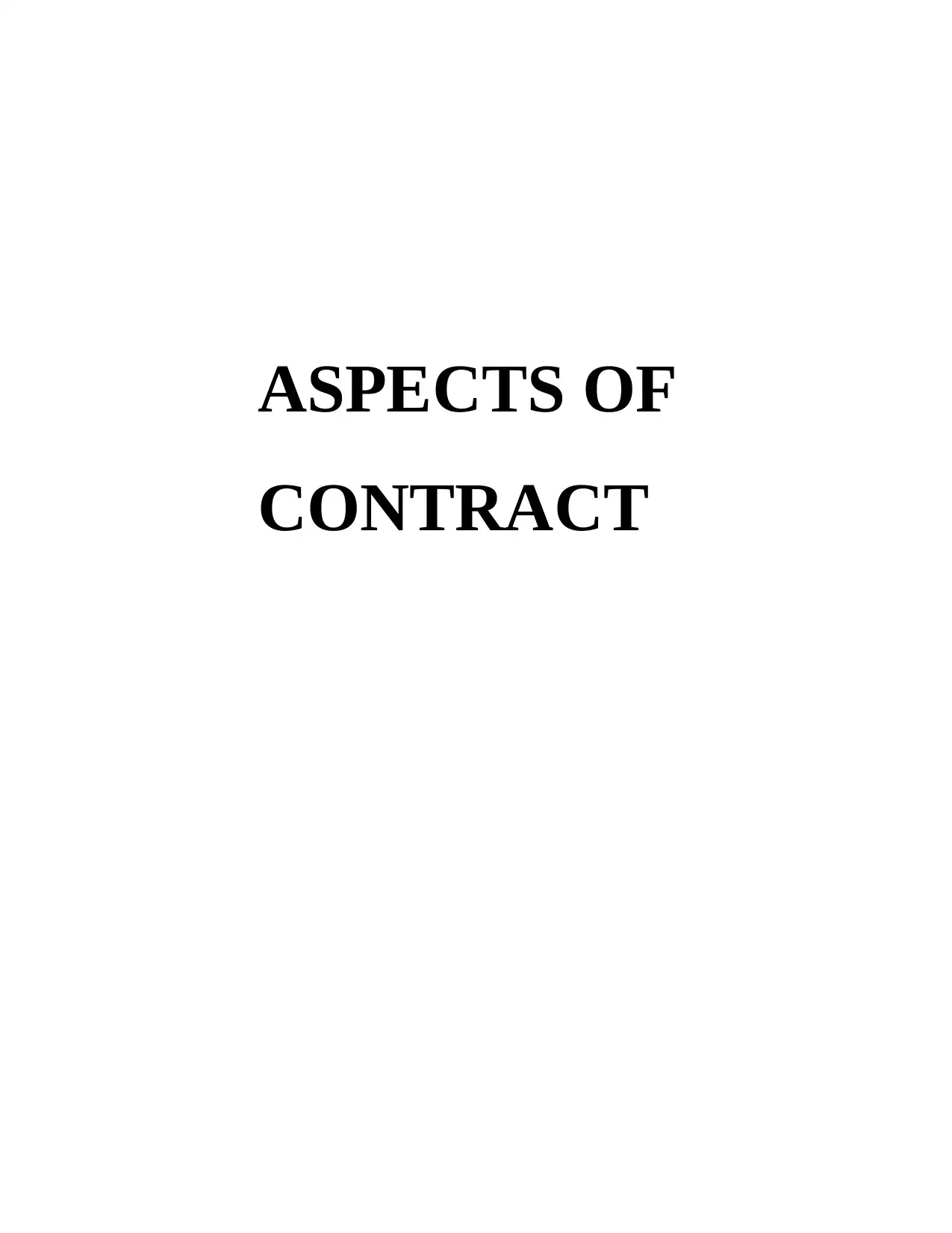
ASPECTS OF
CONTRACT
CONTRACT
Paraphrase This Document
Need a fresh take? Get an instant paraphrase of this document with our AI Paraphraser
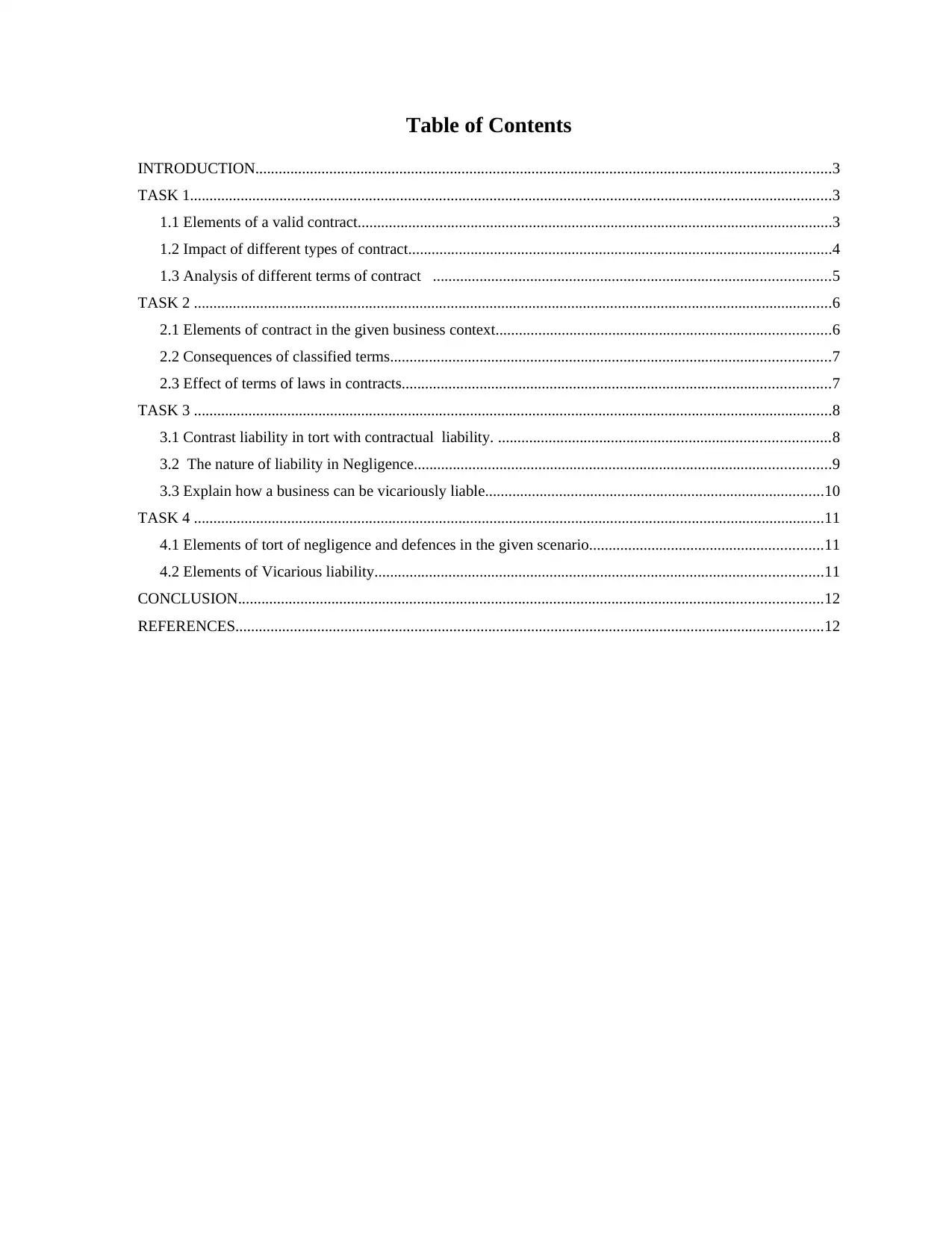
Table of Contents
INTRODUCTION....................................................................................................................................................3
TASK 1.....................................................................................................................................................................3
1.1 Elements of a valid contract..........................................................................................................................3
1.2 Impact of different types of contract.............................................................................................................4
1.3 Analysis of different terms of contract ......................................................................................................5
TASK 2 ....................................................................................................................................................................6
2.1 Elements of contract in the given business context......................................................................................6
2.2 Consequences of classified terms.................................................................................................................7
2.3 Effect of terms of laws in contracts..............................................................................................................7
TASK 3 ....................................................................................................................................................................8
3.1 Contrast liability in tort with contractual liability. .....................................................................................8
3.2 The nature of liability in Negligence...........................................................................................................9
3.3 Explain how a business can be vicariously liable.......................................................................................10
TASK 4 ..................................................................................................................................................................11
4.1 Elements of tort of negligence and defences in the given scenario............................................................11
4.2 Elements of Vicarious liability...................................................................................................................11
CONCLUSION......................................................................................................................................................12
REFERENCES.......................................................................................................................................................12
INTRODUCTION....................................................................................................................................................3
TASK 1.....................................................................................................................................................................3
1.1 Elements of a valid contract..........................................................................................................................3
1.2 Impact of different types of contract.............................................................................................................4
1.3 Analysis of different terms of contract ......................................................................................................5
TASK 2 ....................................................................................................................................................................6
2.1 Elements of contract in the given business context......................................................................................6
2.2 Consequences of classified terms.................................................................................................................7
2.3 Effect of terms of laws in contracts..............................................................................................................7
TASK 3 ....................................................................................................................................................................8
3.1 Contrast liability in tort with contractual liability. .....................................................................................8
3.2 The nature of liability in Negligence...........................................................................................................9
3.3 Explain how a business can be vicariously liable.......................................................................................10
TASK 4 ..................................................................................................................................................................11
4.1 Elements of tort of negligence and defences in the given scenario............................................................11
4.2 Elements of Vicarious liability...................................................................................................................11
CONCLUSION......................................................................................................................................................12
REFERENCES.......................................................................................................................................................12
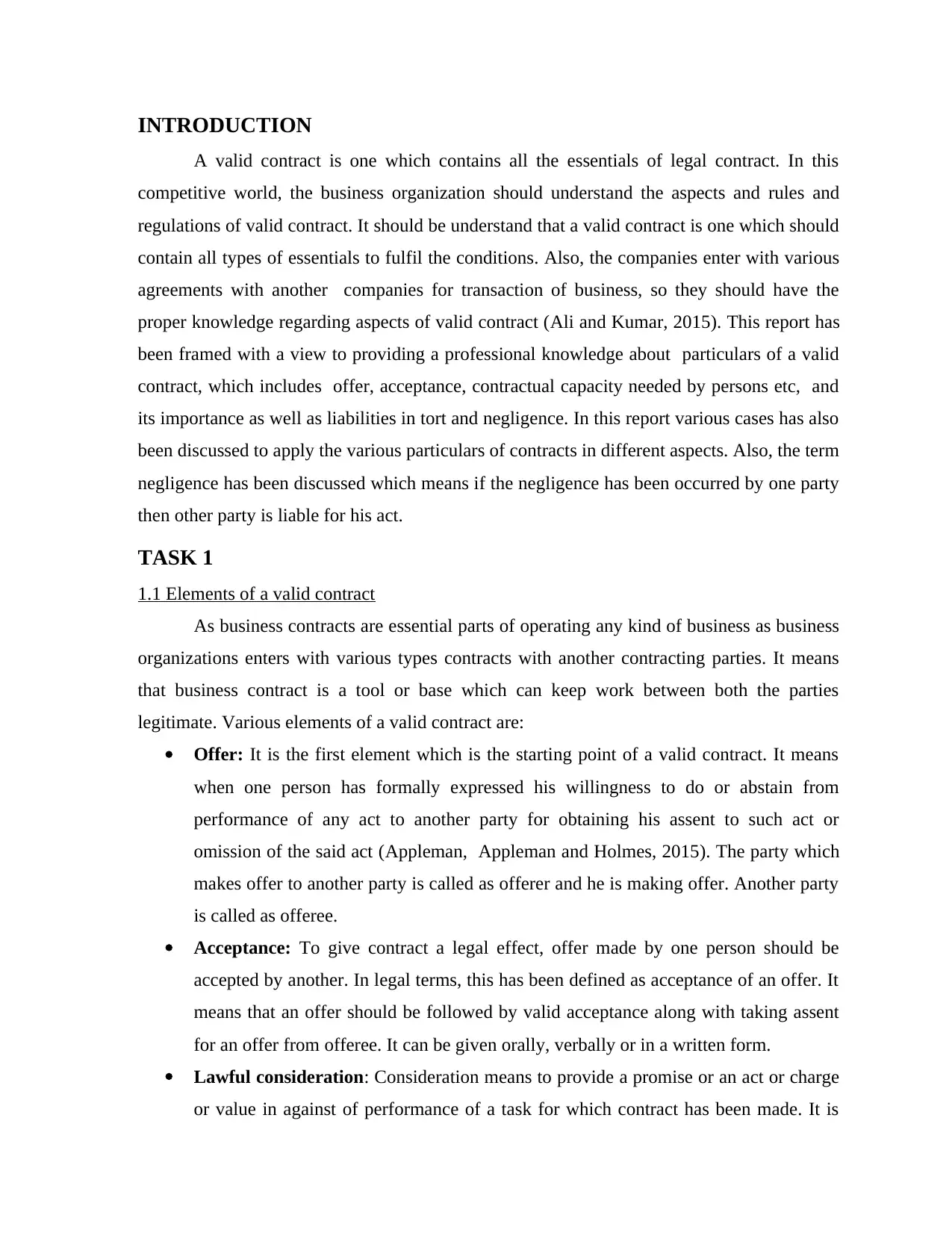
INTRODUCTION
A valid contract is one which contains all the essentials of legal contract. In this
competitive world, the business organization should understand the aspects and rules and
regulations of valid contract. It should be understand that a valid contract is one which should
contain all types of essentials to fulfil the conditions. Also, the companies enter with various
agreements with another companies for transaction of business, so they should have the
proper knowledge regarding aspects of valid contract (Ali and Kumar, 2015). This report has
been framed with a view to providing a professional knowledge about particulars of a valid
contract, which includes offer, acceptance, contractual capacity needed by persons etc, and
its importance as well as liabilities in tort and negligence. In this report various cases has also
been discussed to apply the various particulars of contracts in different aspects. Also, the term
negligence has been discussed which means if the negligence has been occurred by one party
then other party is liable for his act.
TASK 1
1.1 Elements of a valid contract
As business contracts are essential parts of operating any kind of business as business
organizations enters with various types contracts with another contracting parties. It means
that business contract is a tool or base which can keep work between both the parties
legitimate. Various elements of a valid contract are:
Offer: It is the first element which is the starting point of a valid contract. It means
when one person has formally expressed his willingness to do or abstain from
performance of any act to another party for obtaining his assent to such act or
omission of the said act (Appleman, Appleman and Holmes, 2015). The party which
makes offer to another party is called as offerer and he is making offer. Another party
is called as offeree.
Acceptance: To give contract a legal effect, offer made by one person should be
accepted by another. In legal terms, this has been defined as acceptance of an offer. It
means that an offer should be followed by valid acceptance along with taking assent
for an offer from offeree. It can be given orally, verbally or in a written form.
Lawful consideration: Consideration means to provide a promise or an act or charge
or value in against of performance of a task for which contract has been made. It is
A valid contract is one which contains all the essentials of legal contract. In this
competitive world, the business organization should understand the aspects and rules and
regulations of valid contract. It should be understand that a valid contract is one which should
contain all types of essentials to fulfil the conditions. Also, the companies enter with various
agreements with another companies for transaction of business, so they should have the
proper knowledge regarding aspects of valid contract (Ali and Kumar, 2015). This report has
been framed with a view to providing a professional knowledge about particulars of a valid
contract, which includes offer, acceptance, contractual capacity needed by persons etc, and
its importance as well as liabilities in tort and negligence. In this report various cases has also
been discussed to apply the various particulars of contracts in different aspects. Also, the term
negligence has been discussed which means if the negligence has been occurred by one party
then other party is liable for his act.
TASK 1
1.1 Elements of a valid contract
As business contracts are essential parts of operating any kind of business as business
organizations enters with various types contracts with another contracting parties. It means
that business contract is a tool or base which can keep work between both the parties
legitimate. Various elements of a valid contract are:
Offer: It is the first element which is the starting point of a valid contract. It means
when one person has formally expressed his willingness to do or abstain from
performance of any act to another party for obtaining his assent to such act or
omission of the said act (Appleman, Appleman and Holmes, 2015). The party which
makes offer to another party is called as offerer and he is making offer. Another party
is called as offeree.
Acceptance: To give contract a legal effect, offer made by one person should be
accepted by another. In legal terms, this has been defined as acceptance of an offer. It
means that an offer should be followed by valid acceptance along with taking assent
for an offer from offeree. It can be given orally, verbally or in a written form.
Lawful consideration: Consideration means to provide a promise or an act or charge
or value in against of performance of a task for which contract has been made. It is
⊘ This is a preview!⊘
Do you want full access?
Subscribe today to unlock all pages.

Trusted by 1+ million students worldwide
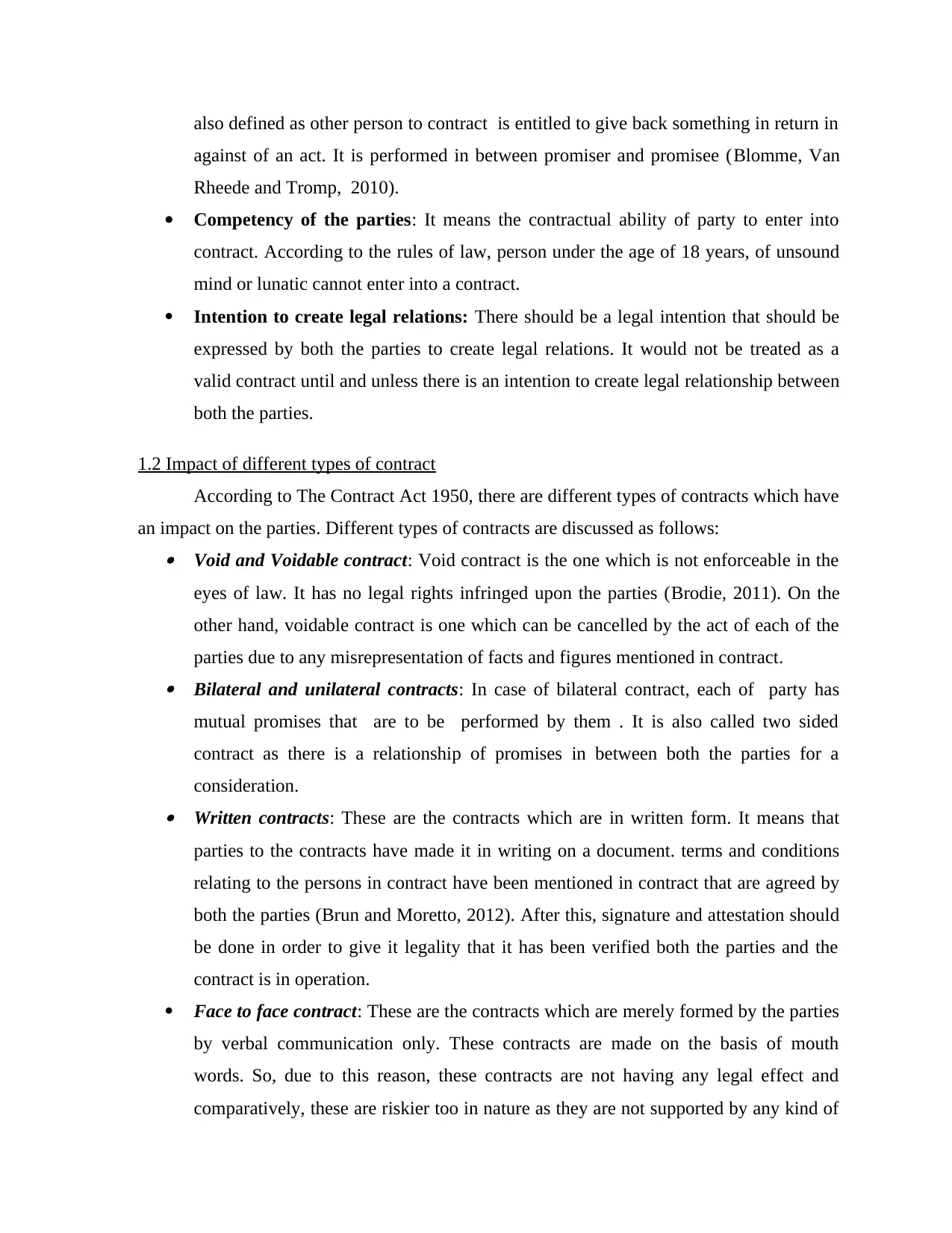
also defined as other person to contract is entitled to give back something in return in
against of an act. It is performed in between promiser and promisee (Blomme, Van
Rheede and Tromp, 2010).
Competency of the parties: It means the contractual ability of party to enter into
contract. According to the rules of law, person under the age of 18 years, of unsound
mind or lunatic cannot enter into a contract.
Intention to create legal relations: There should be a legal intention that should be
expressed by both the parties to create legal relations. It would not be treated as a
valid contract until and unless there is an intention to create legal relationship between
both the parties.
1.2 Impact of different types of contract
According to The Contract Act 1950, there are different types of contracts which have
an impact on the parties. Different types of contracts are discussed as follows:
Void and Voidable contract: Void contract is the one which is not enforceable in the
eyes of law. It has no legal rights infringed upon the parties (Brodie, 2011). On the
other hand, voidable contract is one which can be cancelled by the act of each of the
parties due to any misrepresentation of facts and figures mentioned in contract.
Bilateral and unilateral contracts: In case of bilateral contract, each of party has
mutual promises that are to be performed by them . It is also called two sided
contract as there is a relationship of promises in between both the parties for a
consideration.
Written contracts: These are the contracts which are in written form. It means that
parties to the contracts have made it in writing on a document. terms and conditions
relating to the persons in contract have been mentioned in contract that are agreed by
both the parties (Brun and Moretto, 2012). After this, signature and attestation should
be done in order to give it legality that it has been verified both the parties and the
contract is in operation.
Face to face contract: These are the contracts which are merely formed by the parties
by verbal communication only. These contracts are made on the basis of mouth
words. So, due to this reason, these contracts are not having any legal effect and
comparatively, these are riskier too in nature as they are not supported by any kind of
against of an act. It is performed in between promiser and promisee (Blomme, Van
Rheede and Tromp, 2010).
Competency of the parties: It means the contractual ability of party to enter into
contract. According to the rules of law, person under the age of 18 years, of unsound
mind or lunatic cannot enter into a contract.
Intention to create legal relations: There should be a legal intention that should be
expressed by both the parties to create legal relations. It would not be treated as a
valid contract until and unless there is an intention to create legal relationship between
both the parties.
1.2 Impact of different types of contract
According to The Contract Act 1950, there are different types of contracts which have
an impact on the parties. Different types of contracts are discussed as follows:
Void and Voidable contract: Void contract is the one which is not enforceable in the
eyes of law. It has no legal rights infringed upon the parties (Brodie, 2011). On the
other hand, voidable contract is one which can be cancelled by the act of each of the
parties due to any misrepresentation of facts and figures mentioned in contract.
Bilateral and unilateral contracts: In case of bilateral contract, each of party has
mutual promises that are to be performed by them . It is also called two sided
contract as there is a relationship of promises in between both the parties for a
consideration.
Written contracts: These are the contracts which are in written form. It means that
parties to the contracts have made it in writing on a document. terms and conditions
relating to the persons in contract have been mentioned in contract that are agreed by
both the parties (Brun and Moretto, 2012). After this, signature and attestation should
be done in order to give it legality that it has been verified both the parties and the
contract is in operation.
Face to face contract: These are the contracts which are merely formed by the parties
by verbal communication only. These contracts are made on the basis of mouth
words. So, due to this reason, these contracts are not having any legal effect and
comparatively, these are riskier too in nature as they are not supported by any kind of
Paraphrase This Document
Need a fresh take? Get an instant paraphrase of this document with our AI Paraphraser
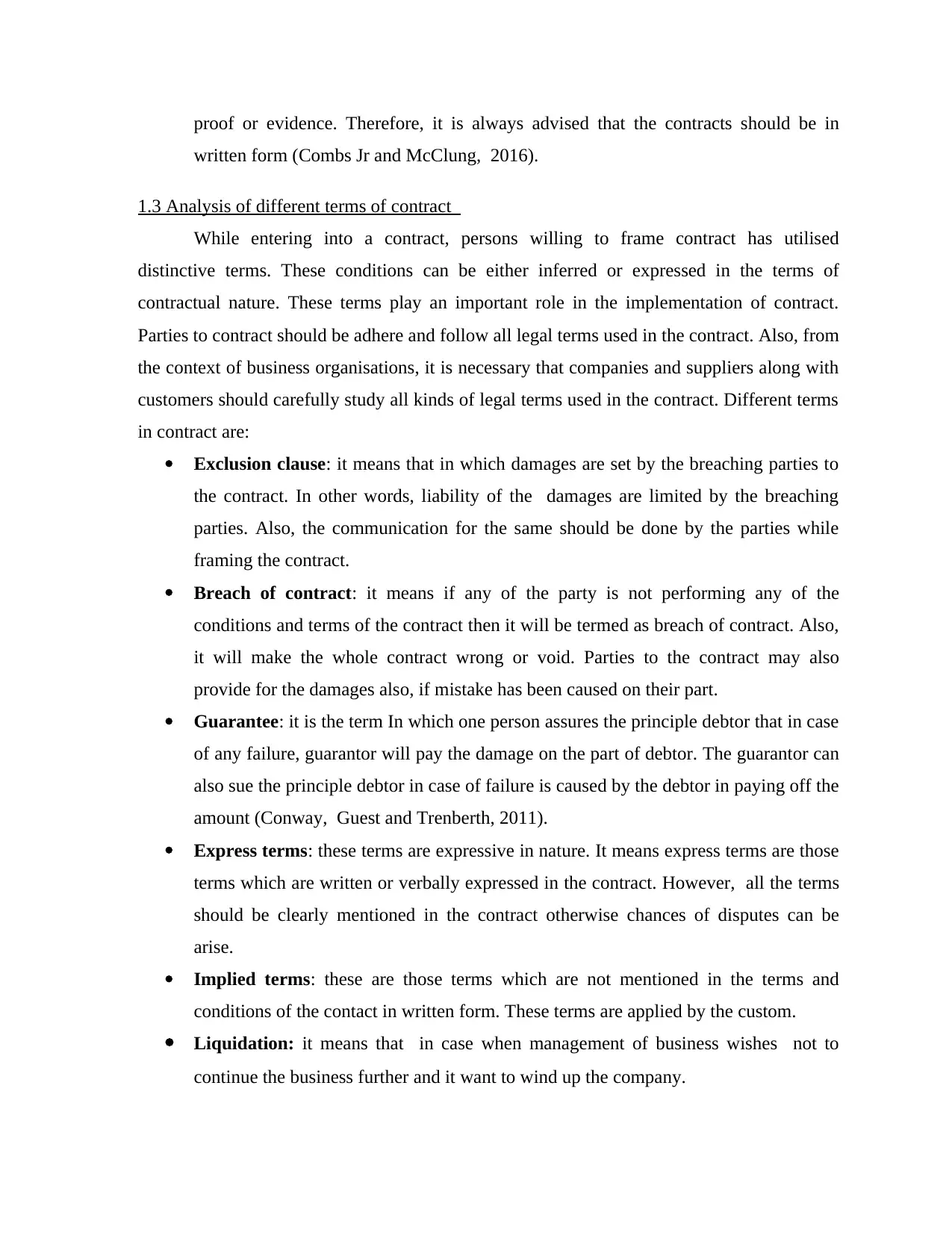
proof or evidence. Therefore, it is always advised that the contracts should be in
written form (Combs Jr and McClung, 2016).
1.3 Analysis of different terms of contract
While entering into a contract, persons willing to frame contract has utilised
distinctive terms. These conditions can be either inferred or expressed in the terms of
contractual nature. These terms play an important role in the implementation of contract.
Parties to contract should be adhere and follow all legal terms used in the contract. Also, from
the context of business organisations, it is necessary that companies and suppliers along with
customers should carefully study all kinds of legal terms used in the contract. Different terms
in contract are:
Exclusion clause: it means that in which damages are set by the breaching parties to
the contract. In other words, liability of the damages are limited by the breaching
parties. Also, the communication for the same should be done by the parties while
framing the contract.
Breach of contract: it means if any of the party is not performing any of the
conditions and terms of the contract then it will be termed as breach of contract. Also,
it will make the whole contract wrong or void. Parties to the contract may also
provide for the damages also, if mistake has been caused on their part.
Guarantee: it is the term In which one person assures the principle debtor that in case
of any failure, guarantor will pay the damage on the part of debtor. The guarantor can
also sue the principle debtor in case of failure is caused by the debtor in paying off the
amount (Conway, Guest and Trenberth, 2011).
Express terms: these terms are expressive in nature. It means express terms are those
terms which are written or verbally expressed in the contract. However, all the terms
should be clearly mentioned in the contract otherwise chances of disputes can be
arise.
Implied terms: these are those terms which are not mentioned in the terms and
conditions of the contact in written form. These terms are applied by the custom.
Liquidation: it means that in case when management of business wishes not to
continue the business further and it want to wind up the company.
written form (Combs Jr and McClung, 2016).
1.3 Analysis of different terms of contract
While entering into a contract, persons willing to frame contract has utilised
distinctive terms. These conditions can be either inferred or expressed in the terms of
contractual nature. These terms play an important role in the implementation of contract.
Parties to contract should be adhere and follow all legal terms used in the contract. Also, from
the context of business organisations, it is necessary that companies and suppliers along with
customers should carefully study all kinds of legal terms used in the contract. Different terms
in contract are:
Exclusion clause: it means that in which damages are set by the breaching parties to
the contract. In other words, liability of the damages are limited by the breaching
parties. Also, the communication for the same should be done by the parties while
framing the contract.
Breach of contract: it means if any of the party is not performing any of the
conditions and terms of the contract then it will be termed as breach of contract. Also,
it will make the whole contract wrong or void. Parties to the contract may also
provide for the damages also, if mistake has been caused on their part.
Guarantee: it is the term In which one person assures the principle debtor that in case
of any failure, guarantor will pay the damage on the part of debtor. The guarantor can
also sue the principle debtor in case of failure is caused by the debtor in paying off the
amount (Conway, Guest and Trenberth, 2011).
Express terms: these terms are expressive in nature. It means express terms are those
terms which are written or verbally expressed in the contract. However, all the terms
should be clearly mentioned in the contract otherwise chances of disputes can be
arise.
Implied terms: these are those terms which are not mentioned in the terms and
conditions of the contact in written form. These terms are applied by the custom.
Liquidation: it means that in case when management of business wishes not to
continue the business further and it want to wind up the company.
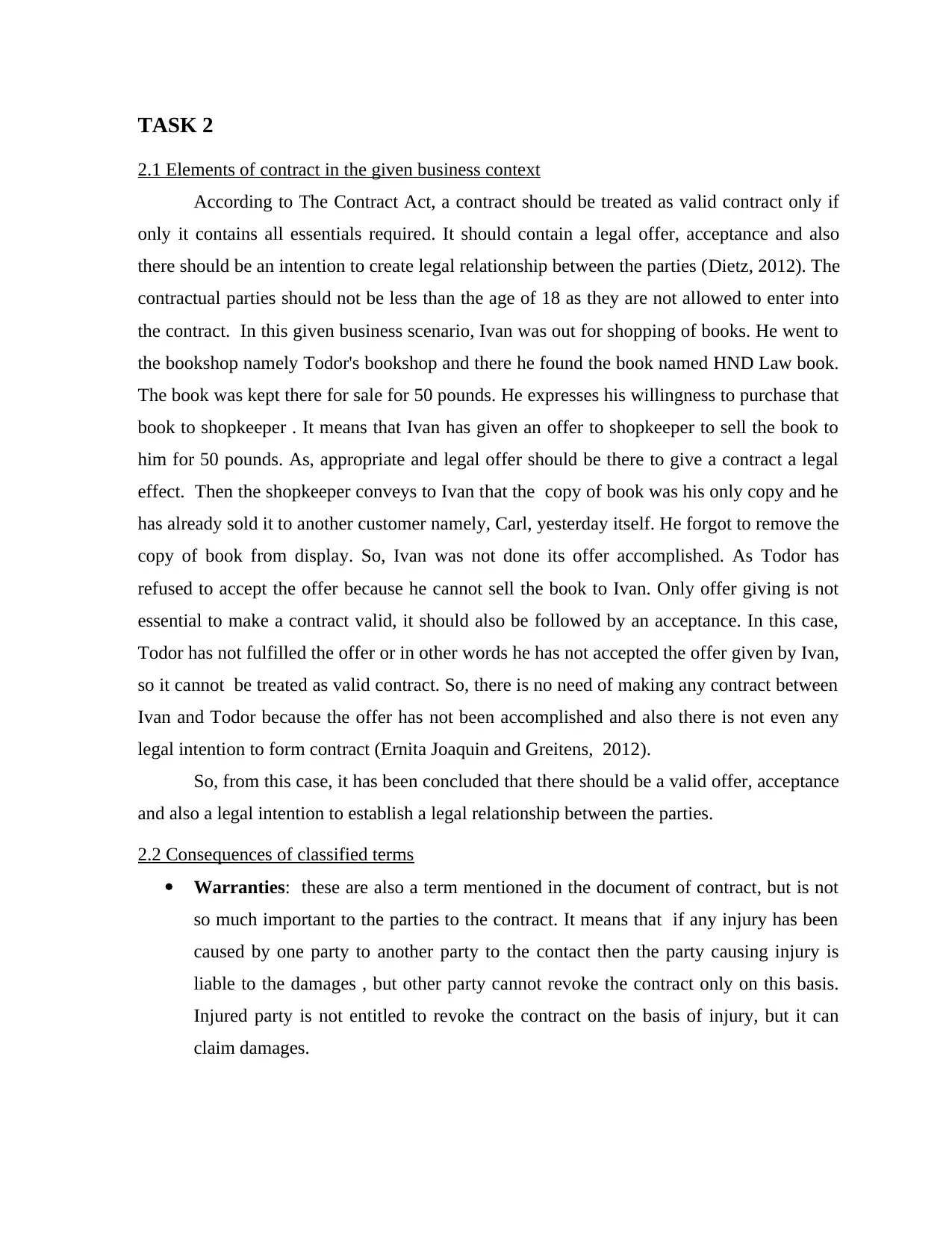
TASK 2
2.1 Elements of contract in the given business context
According to The Contract Act, a contract should be treated as valid contract only if
only it contains all essentials required. It should contain a legal offer, acceptance and also
there should be an intention to create legal relationship between the parties (Dietz, 2012). The
contractual parties should not be less than the age of 18 as they are not allowed to enter into
the contract. In this given business scenario, Ivan was out for shopping of books. He went to
the bookshop namely Todor's bookshop and there he found the book named HND Law book.
The book was kept there for sale for 50 pounds. He expresses his willingness to purchase that
book to shopkeeper . It means that Ivan has given an offer to shopkeeper to sell the book to
him for 50 pounds. As, appropriate and legal offer should be there to give a contract a legal
effect. Then the shopkeeper conveys to Ivan that the copy of book was his only copy and he
has already sold it to another customer namely, Carl, yesterday itself. He forgot to remove the
copy of book from display. So, Ivan was not done its offer accomplished. As Todor has
refused to accept the offer because he cannot sell the book to Ivan. Only offer giving is not
essential to make a contract valid, it should also be followed by an acceptance. In this case,
Todor has not fulfilled the offer or in other words he has not accepted the offer given by Ivan,
so it cannot be treated as valid contract. So, there is no need of making any contract between
Ivan and Todor because the offer has not been accomplished and also there is not even any
legal intention to form contract (Ernita Joaquin and Greitens, 2012).
So, from this case, it has been concluded that there should be a valid offer, acceptance
and also a legal intention to establish a legal relationship between the parties.
2.2 Consequences of classified terms
Warranties: these are also a term mentioned in the document of contract, but is not
so much important to the parties to the contract. It means that if any injury has been
caused by one party to another party to the contact then the party causing injury is
liable to the damages , but other party cannot revoke the contract only on this basis.
Injured party is not entitled to revoke the contract on the basis of injury, but it can
claim damages.
2.1 Elements of contract in the given business context
According to The Contract Act, a contract should be treated as valid contract only if
only it contains all essentials required. It should contain a legal offer, acceptance and also
there should be an intention to create legal relationship between the parties (Dietz, 2012). The
contractual parties should not be less than the age of 18 as they are not allowed to enter into
the contract. In this given business scenario, Ivan was out for shopping of books. He went to
the bookshop namely Todor's bookshop and there he found the book named HND Law book.
The book was kept there for sale for 50 pounds. He expresses his willingness to purchase that
book to shopkeeper . It means that Ivan has given an offer to shopkeeper to sell the book to
him for 50 pounds. As, appropriate and legal offer should be there to give a contract a legal
effect. Then the shopkeeper conveys to Ivan that the copy of book was his only copy and he
has already sold it to another customer namely, Carl, yesterday itself. He forgot to remove the
copy of book from display. So, Ivan was not done its offer accomplished. As Todor has
refused to accept the offer because he cannot sell the book to Ivan. Only offer giving is not
essential to make a contract valid, it should also be followed by an acceptance. In this case,
Todor has not fulfilled the offer or in other words he has not accepted the offer given by Ivan,
so it cannot be treated as valid contract. So, there is no need of making any contract between
Ivan and Todor because the offer has not been accomplished and also there is not even any
legal intention to form contract (Ernita Joaquin and Greitens, 2012).
So, from this case, it has been concluded that there should be a valid offer, acceptance
and also a legal intention to establish a legal relationship between the parties.
2.2 Consequences of classified terms
Warranties: these are also a term mentioned in the document of contract, but is not
so much important to the parties to the contract. It means that if any injury has been
caused by one party to another party to the contact then the party causing injury is
liable to the damages , but other party cannot revoke the contract only on this basis.
Injured party is not entitled to revoke the contract on the basis of injury, but it can
claim damages.
⊘ This is a preview!⊘
Do you want full access?
Subscribe today to unlock all pages.

Trusted by 1+ million students worldwide

Conditions terms: the conditions terms are the most important term in the contract
which has to be formed. This is consists of various terms an conditions which are to
be met by the parties. These are agreed by both the parties. If any of the party is not
able to fulfil the conditions then, injured party has right to file a case in the court
against the breaching party (Grundmann, 2011). In addition to this, these terms are
considered as the most important part of the terms of contact and have a serious
implication in case if its not fulfilled. In this the plaintiff or innocent party has whole
right to repudiate the contract and also it can demand damages also. According to the
judgement of the decided case law: Poussard v Spiers (1876) 1 QBD 410 , Madame
Pousaard breaches the conditions of contract and also spiers was entitled to claim the
damages, ass he missed the opening night in which she was about to perform.
Innominate terms: this term implies that there are certain term and conditions
written , which the parties implies in their contract. But at the time of any dispute, if
the court has not recognised those terms and conditions used by the parties, then these
terms are termed by the court as Innominate terms (Hillman, 2012). The breach of
these terms can be serious , depending upon the terms and conditions of the contract.
2.3 Effect of terms of laws in contracts.
Exemption clause: it is a clause in the contract which enable a party to exclude itself
from liability. It may cause harm to another part as one party will take advantage of it,
unfairly . It is not treated as legal because it is causing injury to other party. According to the
decided case law: Olley v Marlboroough Court Ltd, it has been held that that there is
negligence on the part of hotel management as they failed to take care of their duty and also
the disclaimer was not part of the contract. So, the management was held liable for the
compensation.
In the given case law, John goes to park which is managed by the local council.
Notice has been hanged on which it has been written that by paying 50p, one can get ticket
for chair in the park. John pays 50 p and gets a chair. Later on, he fell down from the chair
because it collapses under him which injured him badly. John complaints to the management
of local council and asks for the compensation from them. The park attendant showed him a
board on which it was written that the management has no liability for any kind of damages
or injury caused by failure of any machine or equipment (Inghammar, 2010). This is an
which has to be formed. This is consists of various terms an conditions which are to
be met by the parties. These are agreed by both the parties. If any of the party is not
able to fulfil the conditions then, injured party has right to file a case in the court
against the breaching party (Grundmann, 2011). In addition to this, these terms are
considered as the most important part of the terms of contact and have a serious
implication in case if its not fulfilled. In this the plaintiff or innocent party has whole
right to repudiate the contract and also it can demand damages also. According to the
judgement of the decided case law: Poussard v Spiers (1876) 1 QBD 410 , Madame
Pousaard breaches the conditions of contract and also spiers was entitled to claim the
damages, ass he missed the opening night in which she was about to perform.
Innominate terms: this term implies that there are certain term and conditions
written , which the parties implies in their contract. But at the time of any dispute, if
the court has not recognised those terms and conditions used by the parties, then these
terms are termed by the court as Innominate terms (Hillman, 2012). The breach of
these terms can be serious , depending upon the terms and conditions of the contract.
2.3 Effect of terms of laws in contracts.
Exemption clause: it is a clause in the contract which enable a party to exclude itself
from liability. It may cause harm to another part as one party will take advantage of it,
unfairly . It is not treated as legal because it is causing injury to other party. According to the
decided case law: Olley v Marlboroough Court Ltd, it has been held that that there is
negligence on the part of hotel management as they failed to take care of their duty and also
the disclaimer was not part of the contract. So, the management was held liable for the
compensation.
In the given case law, John goes to park which is managed by the local council.
Notice has been hanged on which it has been written that by paying 50p, one can get ticket
for chair in the park. John pays 50 p and gets a chair. Later on, he fell down from the chair
because it collapses under him which injured him badly. John complaints to the management
of local council and asks for the compensation from them. The park attendant showed him a
board on which it was written that the management has no liability for any kind of damages
or injury caused by failure of any machine or equipment (Inghammar, 2010). This is an
Paraphrase This Document
Need a fresh take? Get an instant paraphrase of this document with our AI Paraphraser

example of exemption clause according to which there are many stages from which court will
decide that John is entitled to get compensation because the clause was unreasonable.
TASK 3
3.1 Contrast liability in tort with contractual liability.
Contractual and tortious liability is considered to be a vital key in the eyes of law.
Law of tort means the law of civil wrong. Although, every civil wrong is not considered as
the tort. In this, the act of wrong is not considerably a breach of contract or breach of trust or
merely equitable obligation. In the decided case law of Donoghue v Stevenson [1932] AC
562, it was held that claim of Mrs Donoghue was successful as there is a case of negligence
on the part of the cafe which includes carelessness in serving the ginger beer . This case has
been established as a base of tort of negligence in the eyes of law (Isaksson and et. al., 2010).
On the other hand, contractual liability means in which agreement is legally binding
on the parties with their consent. If in case, any party is not bale to fulfil the conditions of the
contract that are expressed in written and verbal for, then parties are held liable for
breaching of contract. In the decided case law of Oscar Chess Ltd v Williams [1957] 1 WLR
370 , the agreements between parties have been made and the parties were required to fulfil
it.
There is a much difference in the liability to tort and contractual liability. In the case
of tort, the source of interest and duty are the creation of law, but on the other hand, in case of
contractual liability interests and duties are created by the parties to the contract at their own
will and terms. In case of Tort, the damages are of unvalidated nature but in the case of
contractual liability, the damages are of liquidated nature. Also, there is a much difference in
tortious and contractual liability is that in case of contractual liability obligations are
voluntarily taken, while in case of tortious liability, obligations are undertaken and imposed
by law (Koffman and Macdonald, 2010.
3.2 The nature of liability in Negligence
Negligence is a term which means the failure to exercise the care that reasonably
should be performed by parties prudently. Negligence involves causes harm that has been
decide that John is entitled to get compensation because the clause was unreasonable.
TASK 3
3.1 Contrast liability in tort with contractual liability.
Contractual and tortious liability is considered to be a vital key in the eyes of law.
Law of tort means the law of civil wrong. Although, every civil wrong is not considered as
the tort. In this, the act of wrong is not considerably a breach of contract or breach of trust or
merely equitable obligation. In the decided case law of Donoghue v Stevenson [1932] AC
562, it was held that claim of Mrs Donoghue was successful as there is a case of negligence
on the part of the cafe which includes carelessness in serving the ginger beer . This case has
been established as a base of tort of negligence in the eyes of law (Isaksson and et. al., 2010).
On the other hand, contractual liability means in which agreement is legally binding
on the parties with their consent. If in case, any party is not bale to fulfil the conditions of the
contract that are expressed in written and verbal for, then parties are held liable for
breaching of contract. In the decided case law of Oscar Chess Ltd v Williams [1957] 1 WLR
370 , the agreements between parties have been made and the parties were required to fulfil
it.
There is a much difference in the liability to tort and contractual liability. In the case
of tort, the source of interest and duty are the creation of law, but on the other hand, in case of
contractual liability interests and duties are created by the parties to the contract at their own
will and terms. In case of Tort, the damages are of unvalidated nature but in the case of
contractual liability, the damages are of liquidated nature. Also, there is a much difference in
tortious and contractual liability is that in case of contractual liability obligations are
voluntarily taken, while in case of tortious liability, obligations are undertaken and imposed
by law (Koffman and Macdonald, 2010.
3.2 The nature of liability in Negligence
Negligence is a term which means the failure to exercise the care that reasonably
should be performed by parties prudently. Negligence involves causes harm that has been
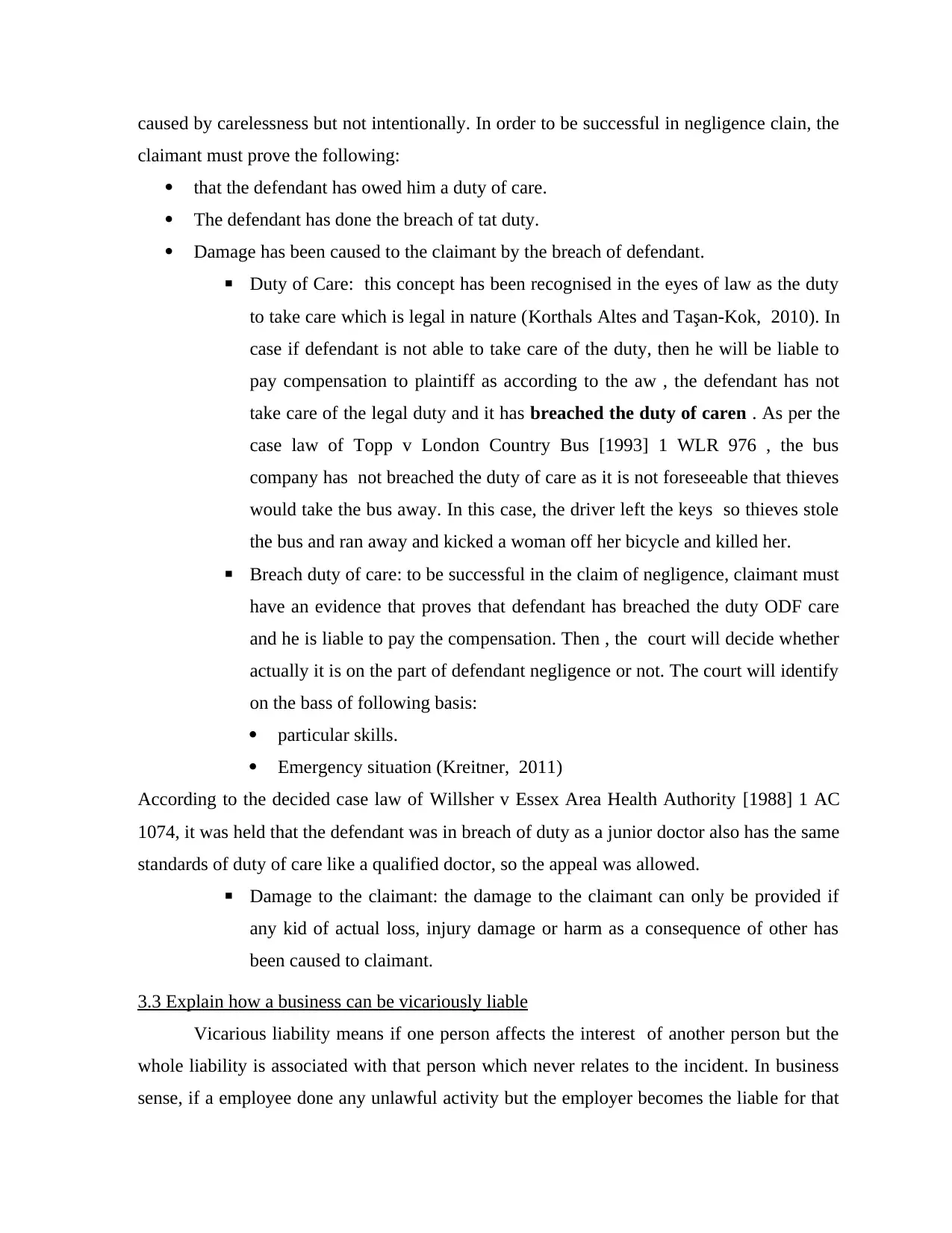
caused by carelessness but not intentionally. In order to be successful in negligence clain, the
claimant must prove the following:
that the defendant has owed him a duty of care.
The defendant has done the breach of tat duty.
Damage has been caused to the claimant by the breach of defendant.
▪ Duty of Care: this concept has been recognised in the eyes of law as the duty
to take care which is legal in nature (Korthals Altes and Taşan-Kok, 2010). In
case if defendant is not able to take care of the duty, then he will be liable to
pay compensation to plaintiff as according to the aw , the defendant has not
take care of the legal duty and it has breached the duty of caren . As per the
case law of Topp v London Country Bus [1993] 1 WLR 976 , the bus
company has not breached the duty of care as it is not foreseeable that thieves
would take the bus away. In this case, the driver left the keys so thieves stole
the bus and ran away and kicked a woman off her bicycle and killed her.
▪ Breach duty of care: to be successful in the claim of negligence, claimant must
have an evidence that proves that defendant has breached the duty ODF care
and he is liable to pay the compensation. Then , the court will decide whether
actually it is on the part of defendant negligence or not. The court will identify
on the bass of following basis:
particular skills.
Emergency situation (Kreitner, 2011)
According to the decided case law of Willsher v Essex Area Health Authority [1988] 1 AC
1074, it was held that the defendant was in breach of duty as a junior doctor also has the same
standards of duty of care like a qualified doctor, so the appeal was allowed.
▪ Damage to the claimant: the damage to the claimant can only be provided if
any kid of actual loss, injury damage or harm as a consequence of other has
been caused to claimant.
3.3 Explain how a business can be vicariously liable
Vicarious liability means if one person affects the interest of another person but the
whole liability is associated with that person which never relates to the incident. In business
sense, if a employee done any unlawful activity but the employer becomes the liable for that
claimant must prove the following:
that the defendant has owed him a duty of care.
The defendant has done the breach of tat duty.
Damage has been caused to the claimant by the breach of defendant.
▪ Duty of Care: this concept has been recognised in the eyes of law as the duty
to take care which is legal in nature (Korthals Altes and Taşan-Kok, 2010). In
case if defendant is not able to take care of the duty, then he will be liable to
pay compensation to plaintiff as according to the aw , the defendant has not
take care of the legal duty and it has breached the duty of caren . As per the
case law of Topp v London Country Bus [1993] 1 WLR 976 , the bus
company has not breached the duty of care as it is not foreseeable that thieves
would take the bus away. In this case, the driver left the keys so thieves stole
the bus and ran away and kicked a woman off her bicycle and killed her.
▪ Breach duty of care: to be successful in the claim of negligence, claimant must
have an evidence that proves that defendant has breached the duty ODF care
and he is liable to pay the compensation. Then , the court will decide whether
actually it is on the part of defendant negligence or not. The court will identify
on the bass of following basis:
particular skills.
Emergency situation (Kreitner, 2011)
According to the decided case law of Willsher v Essex Area Health Authority [1988] 1 AC
1074, it was held that the defendant was in breach of duty as a junior doctor also has the same
standards of duty of care like a qualified doctor, so the appeal was allowed.
▪ Damage to the claimant: the damage to the claimant can only be provided if
any kid of actual loss, injury damage or harm as a consequence of other has
been caused to claimant.
3.3 Explain how a business can be vicariously liable
Vicarious liability means if one person affects the interest of another person but the
whole liability is associated with that person which never relates to the incident. In business
sense, if a employee done any unlawful activity but the employer becomes the liable for that
⊘ This is a preview!⊘
Do you want full access?
Subscribe today to unlock all pages.

Trusted by 1+ million students worldwide
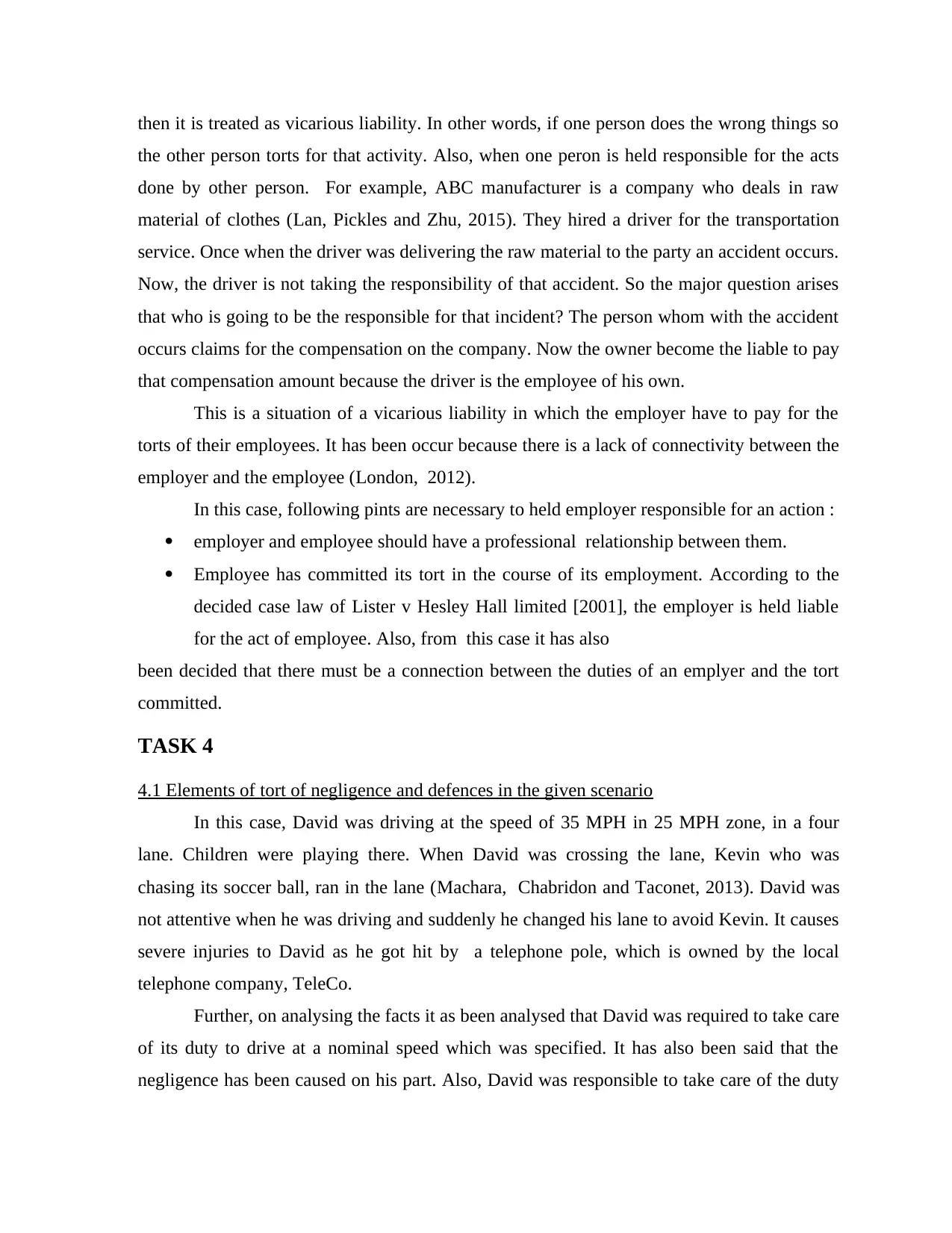
then it is treated as vicarious liability. In other words, if one person does the wrong things so
the other person torts for that activity. Also, when one peron is held responsible for the acts
done by other person. For example, ABC manufacturer is a company who deals in raw
material of clothes (Lan, Pickles and Zhu, 2015). They hired a driver for the transportation
service. Once when the driver was delivering the raw material to the party an accident occurs.
Now, the driver is not taking the responsibility of that accident. So the major question arises
that who is going to be the responsible for that incident? The person whom with the accident
occurs claims for the compensation on the company. Now the owner become the liable to pay
that compensation amount because the driver is the employee of his own.
This is a situation of a vicarious liability in which the employer have to pay for the
torts of their employees. It has been occur because there is a lack of connectivity between the
employer and the employee (London, 2012).
In this case, following pints are necessary to held employer responsible for an action :
employer and employee should have a professional relationship between them.
Employee has committed its tort in the course of its employment. According to the
decided case law of Lister v Hesley Hall limited [2001], the employer is held liable
for the act of employee. Also, from this case it has also
been decided that there must be a connection between the duties of an emplyer and the tort
committed.
TASK 4
4.1 Elements of tort of negligence and defences in the given scenario
In this case, David was driving at the speed of 35 MPH in 25 MPH zone, in a four
lane. Children were playing there. When David was crossing the lane, Kevin who was
chasing its soccer ball, ran in the lane (Machara, Chabridon and Taconet, 2013). David was
not attentive when he was driving and suddenly he changed his lane to avoid Kevin. It causes
severe injuries to David as he got hit by a telephone pole, which is owned by the local
telephone company, TeleCo.
Further, on analysing the facts it as been analysed that David was required to take care
of its duty to drive at a nominal speed which was specified. It has also been said that the
negligence has been caused on his part. Also, David was responsible to take care of the duty
the other person torts for that activity. Also, when one peron is held responsible for the acts
done by other person. For example, ABC manufacturer is a company who deals in raw
material of clothes (Lan, Pickles and Zhu, 2015). They hired a driver for the transportation
service. Once when the driver was delivering the raw material to the party an accident occurs.
Now, the driver is not taking the responsibility of that accident. So the major question arises
that who is going to be the responsible for that incident? The person whom with the accident
occurs claims for the compensation on the company. Now the owner become the liable to pay
that compensation amount because the driver is the employee of his own.
This is a situation of a vicarious liability in which the employer have to pay for the
torts of their employees. It has been occur because there is a lack of connectivity between the
employer and the employee (London, 2012).
In this case, following pints are necessary to held employer responsible for an action :
employer and employee should have a professional relationship between them.
Employee has committed its tort in the course of its employment. According to the
decided case law of Lister v Hesley Hall limited [2001], the employer is held liable
for the act of employee. Also, from this case it has also
been decided that there must be a connection between the duties of an emplyer and the tort
committed.
TASK 4
4.1 Elements of tort of negligence and defences in the given scenario
In this case, David was driving at the speed of 35 MPH in 25 MPH zone, in a four
lane. Children were playing there. When David was crossing the lane, Kevin who was
chasing its soccer ball, ran in the lane (Machara, Chabridon and Taconet, 2013). David was
not attentive when he was driving and suddenly he changed his lane to avoid Kevin. It causes
severe injuries to David as he got hit by a telephone pole, which is owned by the local
telephone company, TeleCo.
Further, on analysing the facts it as been analysed that David was required to take care
of its duty to drive at a nominal speed which was specified. It has also been said that the
negligence has been caused on his part. Also, David was responsible to take care of the duty
Paraphrase This Document
Need a fresh take? Get an instant paraphrase of this document with our AI Paraphraser
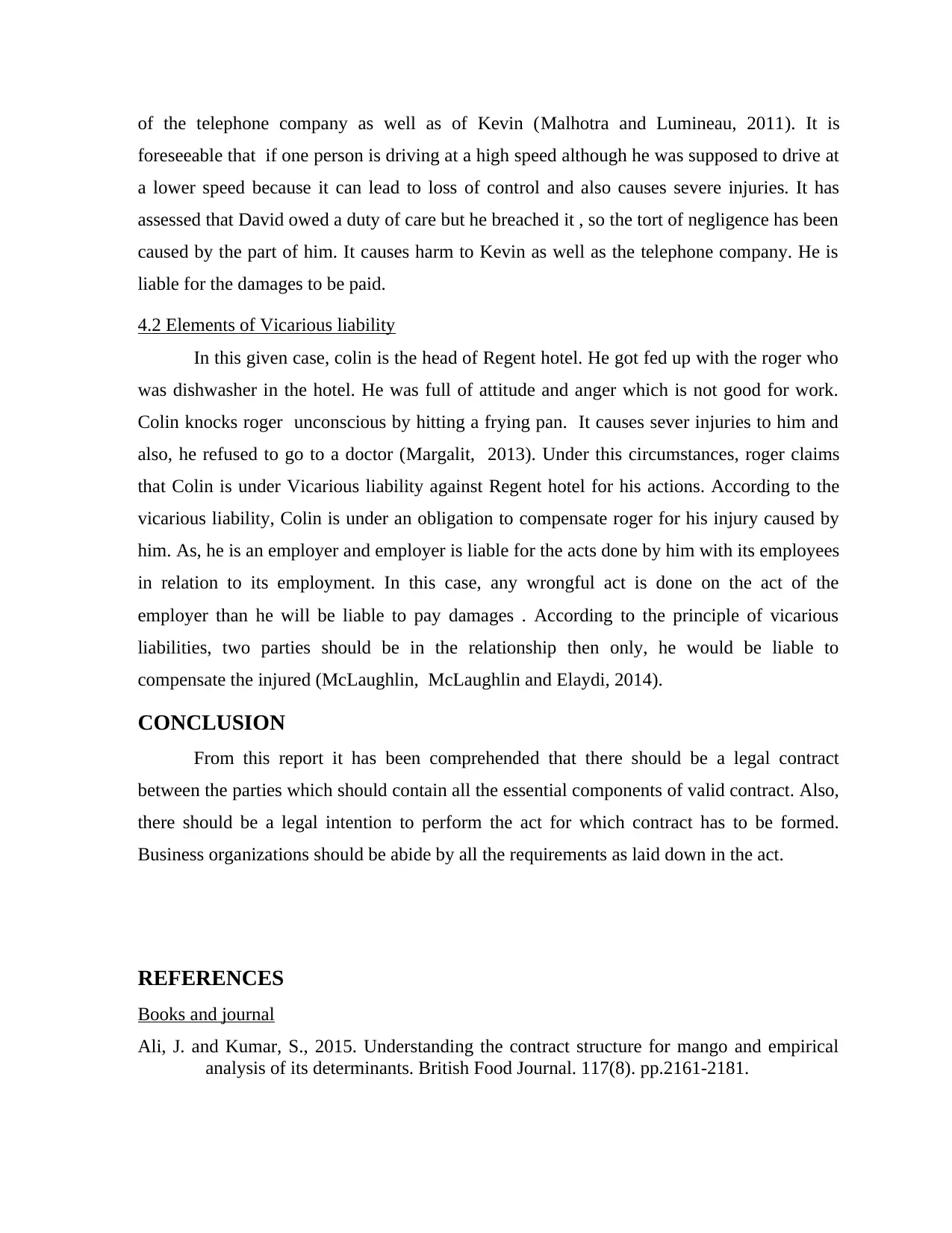
of the telephone company as well as of Kevin (Malhotra and Lumineau, 2011). It is
foreseeable that if one person is driving at a high speed although he was supposed to drive at
a lower speed because it can lead to loss of control and also causes severe injuries. It has
assessed that David owed a duty of care but he breached it , so the tort of negligence has been
caused by the part of him. It causes harm to Kevin as well as the telephone company. He is
liable for the damages to be paid.
4.2 Elements of Vicarious liability
In this given case, colin is the head of Regent hotel. He got fed up with the roger who
was dishwasher in the hotel. He was full of attitude and anger which is not good for work.
Colin knocks roger unconscious by hitting a frying pan. It causes sever injuries to him and
also, he refused to go to a doctor (Margalit, 2013). Under this circumstances, roger claims
that Colin is under Vicarious liability against Regent hotel for his actions. According to the
vicarious liability, Colin is under an obligation to compensate roger for his injury caused by
him. As, he is an employer and employer is liable for the acts done by him with its employees
in relation to its employment. In this case, any wrongful act is done on the act of the
employer than he will be liable to pay damages . According to the principle of vicarious
liabilities, two parties should be in the relationship then only, he would be liable to
compensate the injured (McLaughlin, McLaughlin and Elaydi, 2014).
CONCLUSION
From this report it has been comprehended that there should be a legal contract
between the parties which should contain all the essential components of valid contract. Also,
there should be a legal intention to perform the act for which contract has to be formed.
Business organizations should be abide by all the requirements as laid down in the act.
REFERENCES
Books and journal
Ali, J. and Kumar, S., 2015. Understanding the contract structure for mango and empirical
analysis of its determinants. British Food Journal. 117(8). pp.2161-2181.
foreseeable that if one person is driving at a high speed although he was supposed to drive at
a lower speed because it can lead to loss of control and also causes severe injuries. It has
assessed that David owed a duty of care but he breached it , so the tort of negligence has been
caused by the part of him. It causes harm to Kevin as well as the telephone company. He is
liable for the damages to be paid.
4.2 Elements of Vicarious liability
In this given case, colin is the head of Regent hotel. He got fed up with the roger who
was dishwasher in the hotel. He was full of attitude and anger which is not good for work.
Colin knocks roger unconscious by hitting a frying pan. It causes sever injuries to him and
also, he refused to go to a doctor (Margalit, 2013). Under this circumstances, roger claims
that Colin is under Vicarious liability against Regent hotel for his actions. According to the
vicarious liability, Colin is under an obligation to compensate roger for his injury caused by
him. As, he is an employer and employer is liable for the acts done by him with its employees
in relation to its employment. In this case, any wrongful act is done on the act of the
employer than he will be liable to pay damages . According to the principle of vicarious
liabilities, two parties should be in the relationship then only, he would be liable to
compensate the injured (McLaughlin, McLaughlin and Elaydi, 2014).
CONCLUSION
From this report it has been comprehended that there should be a legal contract
between the parties which should contain all the essential components of valid contract. Also,
there should be a legal intention to perform the act for which contract has to be formed.
Business organizations should be abide by all the requirements as laid down in the act.
REFERENCES
Books and journal
Ali, J. and Kumar, S., 2015. Understanding the contract structure for mango and empirical
analysis of its determinants. British Food Journal. 117(8). pp.2161-2181.
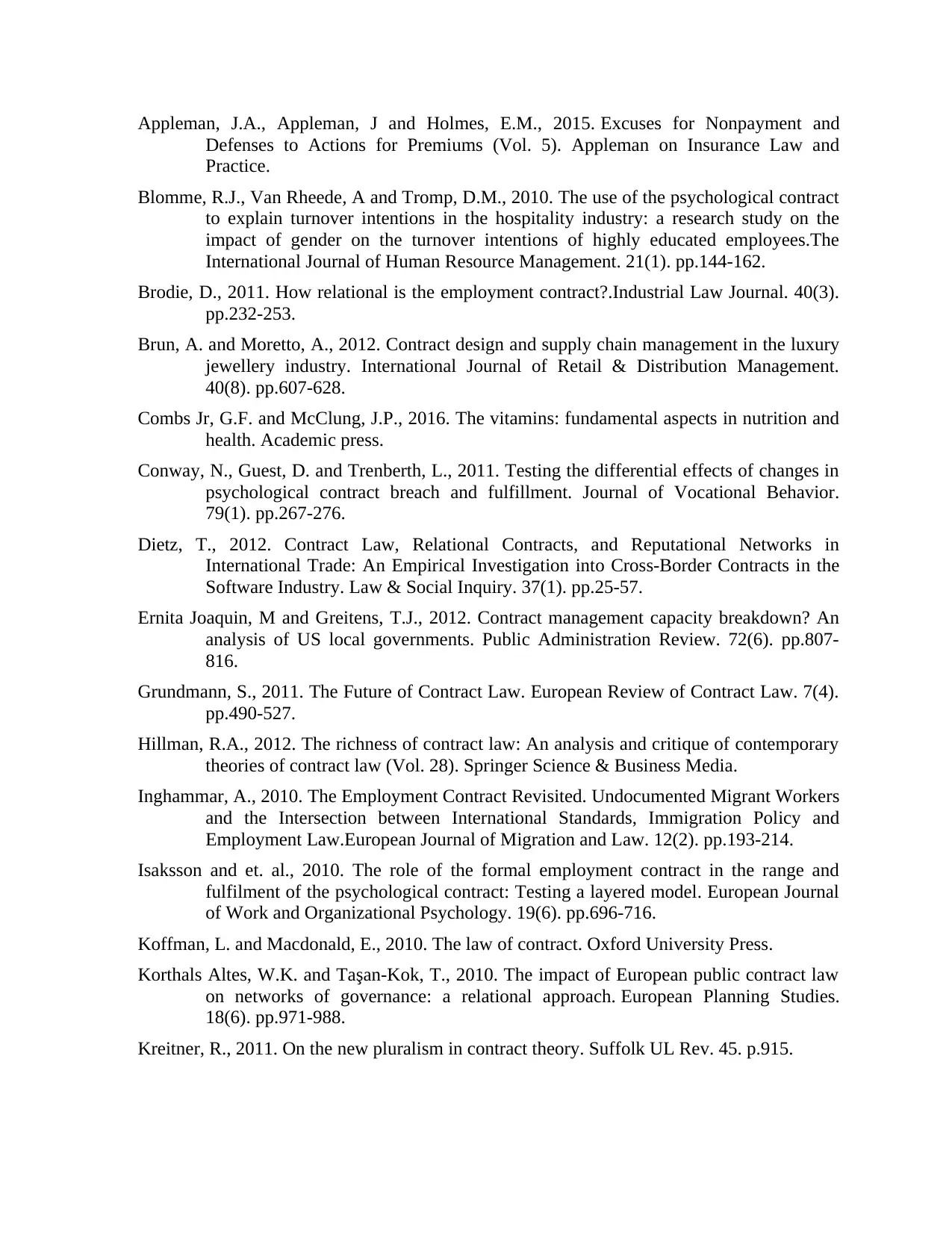
Appleman, J.A., Appleman, J and Holmes, E.M., 2015. Excuses for Nonpayment and
Defenses to Actions for Premiums (Vol. 5). Appleman on Insurance Law and
Practice.
Blomme, R.J., Van Rheede, A and Tromp, D.M., 2010. The use of the psychological contract
to explain turnover intentions in the hospitality industry: a research study on the
impact of gender on the turnover intentions of highly educated employees.The
International Journal of Human Resource Management. 21(1). pp.144-162.
Brodie, D., 2011. How relational is the employment contract?.Industrial Law Journal. 40(3).
pp.232-253.
Brun, A. and Moretto, A., 2012. Contract design and supply chain management in the luxury
jewellery industry. International Journal of Retail & Distribution Management.
40(8). pp.607-628.
Combs Jr, G.F. and McClung, J.P., 2016. The vitamins: fundamental aspects in nutrition and
health. Academic press.
Conway, N., Guest, D. and Trenberth, L., 2011. Testing the differential effects of changes in
psychological contract breach and fulfillment. Journal of Vocational Behavior.
79(1). pp.267-276.
Dietz, T., 2012. Contract Law, Relational Contracts, and Reputational Networks in
International Trade: An Empirical Investigation into Cross‐Border Contracts in the
Software Industry. Law & Social Inquiry. 37(1). pp.25-57.
Ernita Joaquin, M and Greitens, T.J., 2012. Contract management capacity breakdown? An
analysis of US local governments. Public Administration Review. 72(6). pp.807-
816.
Grundmann, S., 2011. The Future of Contract Law. European Review of Contract Law. 7(4).
pp.490-527.
Hillman, R.A., 2012. The richness of contract law: An analysis and critique of contemporary
theories of contract law (Vol. 28). Springer Science & Business Media.
Inghammar, A., 2010. The Employment Contract Revisited. Undocumented Migrant Workers
and the Intersection between International Standards, Immigration Policy and
Employment Law.European Journal of Migration and Law. 12(2). pp.193-214.
Isaksson and et. al., 2010. The role of the formal employment contract in the range and
fulfilment of the psychological contract: Testing a layered model. European Journal
of Work and Organizational Psychology. 19(6). pp.696-716.
Koffman, L. and Macdonald, E., 2010. The law of contract. Oxford University Press.
Korthals Altes, W.K. and Taşan-Kok, T., 2010. The impact of European public contract law
on networks of governance: a relational approach. European Planning Studies.
18(6). pp.971-988.
Kreitner, R., 2011. On the new pluralism in contract theory. Suffolk UL Rev. 45. p.915.
Defenses to Actions for Premiums (Vol. 5). Appleman on Insurance Law and
Practice.
Blomme, R.J., Van Rheede, A and Tromp, D.M., 2010. The use of the psychological contract
to explain turnover intentions in the hospitality industry: a research study on the
impact of gender on the turnover intentions of highly educated employees.The
International Journal of Human Resource Management. 21(1). pp.144-162.
Brodie, D., 2011. How relational is the employment contract?.Industrial Law Journal. 40(3).
pp.232-253.
Brun, A. and Moretto, A., 2012. Contract design and supply chain management in the luxury
jewellery industry. International Journal of Retail & Distribution Management.
40(8). pp.607-628.
Combs Jr, G.F. and McClung, J.P., 2016. The vitamins: fundamental aspects in nutrition and
health. Academic press.
Conway, N., Guest, D. and Trenberth, L., 2011. Testing the differential effects of changes in
psychological contract breach and fulfillment. Journal of Vocational Behavior.
79(1). pp.267-276.
Dietz, T., 2012. Contract Law, Relational Contracts, and Reputational Networks in
International Trade: An Empirical Investigation into Cross‐Border Contracts in the
Software Industry. Law & Social Inquiry. 37(1). pp.25-57.
Ernita Joaquin, M and Greitens, T.J., 2012. Contract management capacity breakdown? An
analysis of US local governments. Public Administration Review. 72(6). pp.807-
816.
Grundmann, S., 2011. The Future of Contract Law. European Review of Contract Law. 7(4).
pp.490-527.
Hillman, R.A., 2012. The richness of contract law: An analysis and critique of contemporary
theories of contract law (Vol. 28). Springer Science & Business Media.
Inghammar, A., 2010. The Employment Contract Revisited. Undocumented Migrant Workers
and the Intersection between International Standards, Immigration Policy and
Employment Law.European Journal of Migration and Law. 12(2). pp.193-214.
Isaksson and et. al., 2010. The role of the formal employment contract in the range and
fulfilment of the psychological contract: Testing a layered model. European Journal
of Work and Organizational Psychology. 19(6). pp.696-716.
Koffman, L. and Macdonald, E., 2010. The law of contract. Oxford University Press.
Korthals Altes, W.K. and Taşan-Kok, T., 2010. The impact of European public contract law
on networks of governance: a relational approach. European Planning Studies.
18(6). pp.971-988.
Kreitner, R., 2011. On the new pluralism in contract theory. Suffolk UL Rev. 45. p.915.
⊘ This is a preview!⊘
Do you want full access?
Subscribe today to unlock all pages.

Trusted by 1+ million students worldwide
1 out of 13
Related Documents
Your All-in-One AI-Powered Toolkit for Academic Success.
+13062052269
info@desklib.com
Available 24*7 on WhatsApp / Email
![[object Object]](/_next/static/media/star-bottom.7253800d.svg)
Unlock your academic potential
Copyright © 2020–2025 A2Z Services. All Rights Reserved. Developed and managed by ZUCOL.





